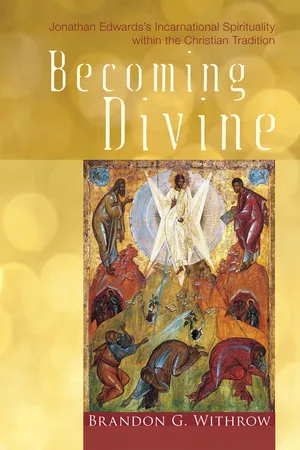1
The Illuminating Word and Spirituality from Antiquity to the Early Reformation
There can be no doubt,” declares David Bebbington, “that Edwards was the chief architect of the theological structures erected by Evangelicals in the Reformed tradition. That was sufficient to ensure that they were built on Enlightenment foundations.” Though it is apparent from his notes that Edwards never fails to notice the latest tomes and buzzwords of the eighteenth century, Bebbington’s conclusion is an overstatement. Edwards belongs (only partly self-consciously) to a long tradition that an eighteenth-century aristocrat from a theological dynasty could not avoid. He engages that tradition only selectively in his notes but understands its value nonetheless. This present chapter looks broadly at that tradition, from ancient beginnings to its transformation in the early Reformation.
Much like the mystics of earlier centuries, Edwards understands union with God as allowing the soul to see the divine being in all things, including both the book of nature and the book of Scripture. Christians of all generations have understood the light of the Bible as inseparable from the light of salvation; the illumined word and the illumined soul always have some connection for the Christian faith; and this is no less true for Edwards. Human beings transformed by the Spirit think God’s thoughts after him because they are united to him through their union with the incarnate Christ by the bond of the Spirit. In this union, everything appears much grander; i.e., ancient Christians found in this an opportunity for allegorizing the biblical text, and Reformed Christians who discarded allegorism in favor of stronger literalism still embraced its cousin, typology.
Edwards is a man between worlds. He is neither a conservative literalist nor a liberal allegorist, and he does not see a need to build tension between the two. “There is a medium,” he writes, “between those that cry down all types, and those that are for turning all into nothing but allegory and not having it to be true history; and also the way of the rabbis that find so many mysteries in letters.” To understand Edwards, then, is to first understand the changing themes in the world of biblical interpretation and its connection to the theology of a transformed soul, particularly as themes of divine participation (deification) and incarnation were explored from the ancient world to Reformation Christianity. Many ancient thinkers understood the reading of Scripture as a participation in something beyond this world, an ascent of the soul into paradise, and this has important implications for the spirituality of Edwards centuries later. In the midst of the Enlightenment’s rejection of this form of thinking, these ancient themes not only connect Edwards to the broader Christian tradition in significant ways, but also help transform his understanding of his own conversion and his reading of the sacred text.
The Spirituality of Ancient Jewish Interpretation
The Bible, while not the oldest human document, has a long history of interpretation that transcends languages and cultures. That might seem to be stating the obvious, but it can be easy to forget that modernist or postmodernist approaches to Scripture are mere newborns in the history of biblical interpretation. In reality, biblical interpretation began long before the Bible itself was finished, especially in its Christian-specific form. The Hebrew Bible, or the Tanak, namely the Torah (Law), Neviim (prophets), and Ketuvim (writings) were not created in a vacuum. Thus scholars are not surprised to find the writer of the biblical book of Daniel (9:24–27) offering a prophetic inner-biblical commentary on the prophecy of seventy years of captivity to Babylon found in the biblical book of Jeremiah (25:11; 29:10). And as a larger Christian book, the Apostle Paul, in his Epistle to the Galatians (4:24), interprets the Genesis narrative with the fresh paint of allegory.
Between the time of the Tanak and the Christian New Testament, an entirely new interpretive tradition arose. The Apocryphal (meaning “hidden things”) and Pseudepigraphal (meaning “falsely attributed”) books offer their own perspectives on the Tanak. Circulating during what is called the Second Temple period (516 BCE—70 CE), some of the apocryphal texts make it into certain canon lists during the earliest Christian periods, only to be removed by subsequent generations, the most famous removals being those by Protestants during the Reformation who treat them as useful for reading but not for dogma. Some of these Second Temple texts, like First Enoch (1:9), for example, were considered acceptable enough to be quoted with some authority by the author of the New Testament book of Jude (14–15), but not acceptable enough to be considered canon by subsequent generations of Christians. A history of biblical interpretation was already in place before a finished Bible existed, and such an interpretative history sets precedents for new approaches to follow.
Mirroring their neighboring cultures, ancient Jewish and Christian interpreters engaged in creative methods of biblical interpretation that became well entrenched by the Middle Ages. The ancient Jewish fourfold sense of interpretation (or PaRDeS, known as peshat, remez, derash, and sod) best represents this creativity. The acronym became short for “paradise” and was understood by Jews in late antiquity to consist of multiple heavenly layers, traditionally seven layers (based on ancient descriptions), tho...
